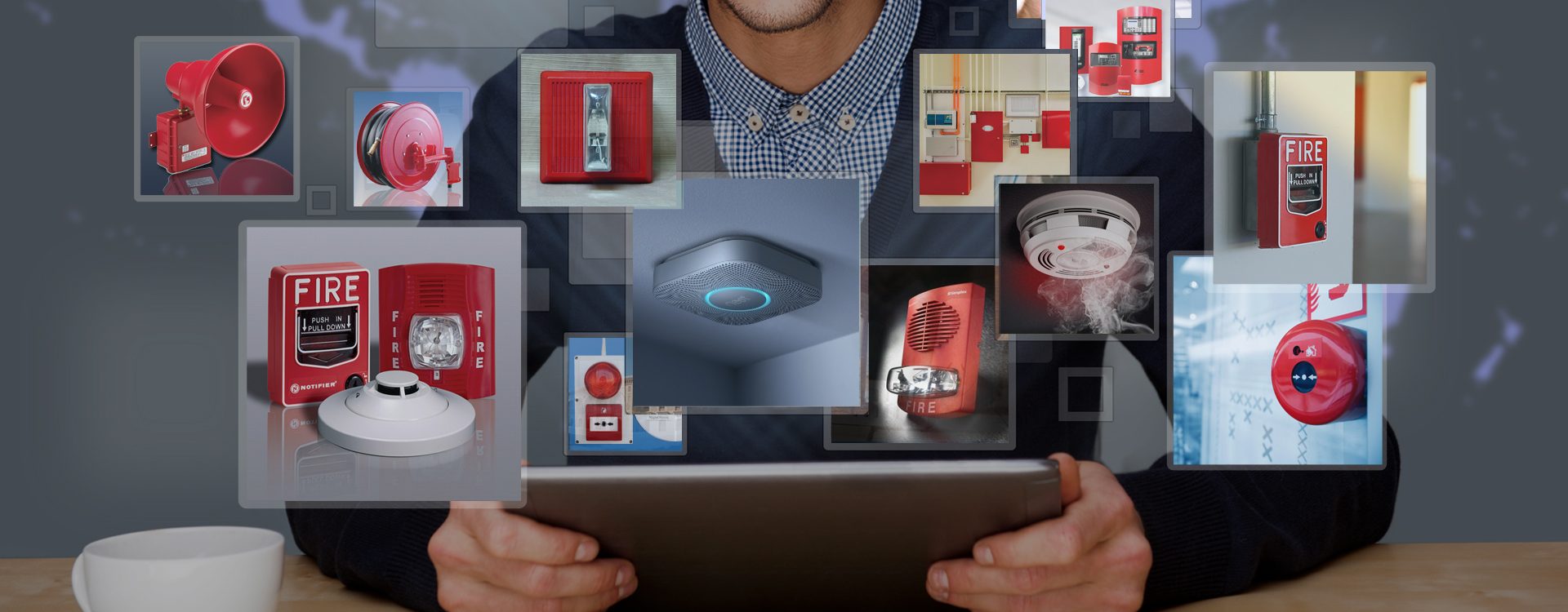
WHAT IS FIRE ALARM SYSTEM ?
A fire alarm system is a circuit that performs a fire and incident observation and informs the user of that location about the same incident. Over the years since automatic fire detection and alarm systems were introduced for general use the technology that has been employed has changed from a very simple battery-powered electrical circuit to advance systems which have many microprocessors based circuit to meet the current demands. The most important component of a fire alarm system is the control panel which includes this microprocessor.
In FAS System initiating device, like smoke detectors, Heat detectors, manual call points, and proactive devices like sprinklers give signals in the form of low voltage to different types of addressable or conventional panel. Then Panel activates output devices like siren, bells, horns, buzzers, chimes & strobe lights. A control panel connects the initiating devices and the notification appliances together to form a system. The basic fire detection and alarm system consists of the following:
- Control Panel – The center of the system that controls the functions of the system.
- Initiating Devices – The devices that provide the input to the control panel in the form of low voltage when they are activated.
- Informer Appliances – The devices that inform or notify the user of a building for the fire incident.
- Power Supplies – There are two types of power supply in FAS System. Primary power supply which gives AC power to panel & another one is Secondary power supply in which battery is used to supply DC power to panel. When primary power supply interrupts, secondary power supply automatically starts operating and gives power to the panel.
The modern advanced FAS is capable of detecting smoke and heat from a small flame, water flow in a sprinkler system or an activated pull station, and reporting this information to users or people on site via dedicated digital communication or anywhere the world. FAS looks very simple in terms of installation point of view, but it works on complex configuration. When we consider the FAS it holds enormous moral and legal responsibilities involved because its directly related to lives. Hence while designing FAS System Installer should consider every aspect very carefully.
HOW FIRE ALARM SYSTEM WORKS ?
While selecting Fire alarm system for any premises it is very important to study all conditions and parameters carefully and on that basis only, installers finalise which type of system is to be install whether it’s working on wired technology or wireless. Then whether it’s conventional or addressable. FAS is mainly classified as
Wireless fire alarm
Wireless fire alarm system– In wireless fire alarm system various devices are connected to each other via radio frequency. Detectors or initiating devices and informer devices are powered by batteries. Since cabling is not required in wireless FAS , hence Installation and maintenance of wireless system are easy and less time consuming as compare to wired devices. On location where all interior works are already done in that scenario wireless FAS is useful. In wired FAS if cable get damaged then whole system gets affected while in wireless system if any component damaged then only that device need to be changed. Updating devices is very easy and system can be easily scalable as compared to wired system.
Wired alarm system
Wired fire alarm system– In wired system as name suggest all devices are connected through wire. In this system special armoured cables are used. Wired system runs on primary power source as electricity & secondary power source as batteries. When we use wired system then there is no problem of signal interference and this is the common problem in wireless solution. Wired system is economical as compared to wireless in most of cases. Installation is bulky & time consuming in wired system but can be performed by less skilled worker as compare to wireless solution.
Both wireless & wired solution is have their own advantages and disadvantages .Finally it depends on User and site condition that which one is to be use. In both the technology again there are two kind of system.
- Conventional system
- Addressable system
In both kind of alarm system initiating devices are connected via cable to control panel and devices are also almost same, except panel. But the main difference is that in addressable system you can identify in which device at which location has been triggered. In addressable system all attached devices connected to panel has a unique address, which helps panel to identify which device is triggered. This helps operator to find precise location where incident took place. While in conventional solution whole system is divided into zones like outdoor area, first floor, second floor indoor area. And when incident occurs then operator comes to know that in which area it happened not the exact location.
In conventional system all devices are connected to control panel by individual wire, there is no sharing of devices. Each cables one end is connected to device and another to panel. While in case of addressable system all devices are connected in line through single cable. Cable start from panel and loops from device to device and again comes to panel. Addressable system are economical as compared to conventional because it consume less wire for installation, less time for installation and maintenance work. So many advance future are available in addressable while they are not in conventional. Addressable system are more reliable as compared to conventional system because wire starts and in panel only and if cuts from any end then also system work properly. Even if any device become faulty system will not disabled. Hence addressable system is superior then conventional system.
There are five types of fire alarm system detectors.
Heat detectors
Smoke detectors
Carbon monoxide detectors
Multi-sensor detectors
Manual call points
Heat detectors-A heat detectors are a devices which responds when the heat of a fire increase the temperature of a heat sensitive element. It can be used in Server room, battery room etc.
Smoke detectors-A smoke detectors is a device that sense smoke ,typically as an indicator of fire.
Carbon monoxide detectors- Carbon monoxide detectors is device that detects the carbon monoxide gas to preven carbon monoxide poisoning.
Multi- sensor detectors- Multi-sensor detectors detects more then one fire phenomena .there are two types optical and Heat detection.
Manual call points- Although automatic sensors are there but in case of emergency manual buttons are provided having frangible element in it. Manual call point is called Break Glass call points.
WHY TO USES FIRE ALARM SYSTEMS ?
Fire alarms systems are used as preventive measure, primarily designed to alert occupants of a fire so they can safely evacuate the premises. There are several reasons and benefits of fire alarm system,
It helps to save lives.
It reduces property loss.
It helps businesses to reduce their downtime.
It helps to fulfil law compliances.
WHERE TO USES FIRE ALARM SYSTEM ?
In accordance to safety measures by several government and private bodies, Fire alarm system are mandatory for locations where mass public gathers and for industrial locations.Below are some locations where FAS is used,
Factories & workshop
Multiplexes & Malls
Hospitals
Schools
Corporate Parks
Airports & Railways
Hotels etc.
